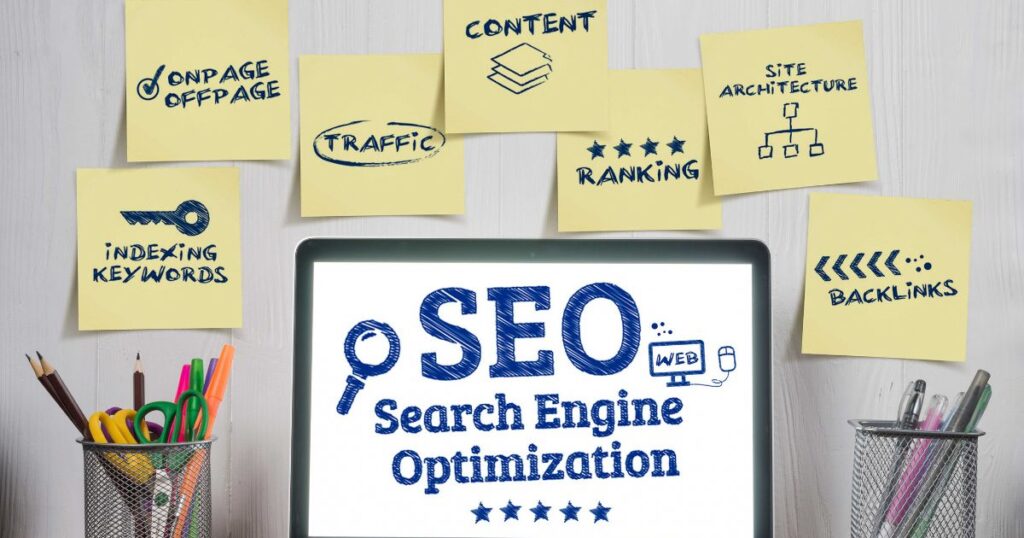Introduction
In the ever-evolving world of Ecommerce, having a strong SEO strategy is crucial for driving organic traffic and increasing online visibility. However, there are several common mistakes that Ecommerce websites make when it comes to SEO.
By avoiding these mistakes, you can ensure that your website ranks higher in search engine results and attracts more potential customers.
Let’s delve into 29 common SEO mistakes to avoid on Ecommerce websites in 2023.
- Introduction
- SEO Strategy
- Keyword Research
- On-Page SEO Mistakes
- 3. Not Optimizing Product Descriptions for Keywords
- 4. No SEO Copy on Collection Pages
- 5. Over-Optimizing for Search Engines
- 6. Missing Or Poorly Optimized Meta Tags
- 7. Ignoring Header Tags
- 8. Lack of Keyword-Rich URLs for Product Pages
- 9. Not Using Internal Linking
- 10. Ignoring Image SEO
- 11. Not Optimizing Videos (Descriptions and Transcripts)
- Off-Page SEO Mistakes
- Site Structure & Navigation
- Mobile Optimization
- Technical SEO
- Local SEO
- User-Generated Content (UGC)
- Analysis and Optimization
- Conclusion
- Further Reading:
SEO Strategy
1. Not Having an SEO Plan
SEO shouldn’t be just an afterthought. One of the biggest mistakes Ecommerce websites make is not having a well-defined SEO strategy in place.
Without a clear plan, it becomes difficult to optimize your website effectively and achieve your desired goals.
Take the time to research and outline your SEO strategy, including keyword mapping for each landing page, blog content strategy, on-page optimization, and off-page promotion.
Keyword Research
A thorough keyword research is at the base of every SEO strategy. What keywords are relevant to my products? What keywords are relevant to my target audience?
Tools like the Google Keyword Planner, SEMrush, or Ahrefs are great for this. Use them in combination with the Google SERP (a real goldmine) in your keyword research.
Here are some common mistakes in this topic.
2. Only Targeting Highly Competitive Keywords
While it may be tempting to target popular, high-volume keywords, it can be challenging to rank for them, especially for newer or smaller Ecommerce websites.
Instead, focus on long-tail keywords that are more specific and have lower competition. For example, instead of targeting “shoes,” target “women’s running shoes for flat feet.”
Focusing only on high-volume, super competitive keywords, might result in wasting your time and money on activity that will bring little results.

Long-tail keywords are essential for capturing targeted traffic and attracting potential customers who are closer to making a purchase.
By neglecting long-tail keywords, you miss out on valuable opportunities to rank higher in search engine results and drive relevant traffic to your Ecommerce website.
Make sure to include those in URLs and texts of categories, products, and blog articles, as well as in image alt tags.
Example:
If you sell rugs, don’t only create a category URL /rugs. You should also create URLs for relevant long-tail keywords such as living room rugs, kids rugs, jute rugs, wool rugs etc. Each of these pages will target a more specific interest from your potential customers, and increase your opportunities to get free organic clicks.
On-Page SEO Mistakes
On-page SEO means all elements that are on your online store and thus can be controlled by you. Tackling on-page SEO issues should be among the first things you do when optimizing your online store’s SEO.
3. Not Optimizing Product Descriptions for Keywords
Product descriptions are a crucial element of Ecommerce websites. Optimizing them with relevant keywords helps search engines understand the content and rank your product pages higher.
Ensure that your product descriptions are unique, informative, and keyword-rich. Make sure that they’re not too long either so that customers can find the most relevant information easily.
4. No SEO Copy on Collection Pages
SEO copy is a great opportunity for online stores to add relevant keywords that the page can rank for. This copy can explain the category, and offer a buying guide or care tips.
5. Over-Optimizing for Search Engines
While it’s important to optimize your ecommerce website for search engines, overdoing it can negatively impact your SEO performance. Common over-optimization mistakes include keyword stuffing, using irrelevant meta tags, and creating duplicate content.
Prioritize user experience and natural language over cramming your content with keywords.
6. Missing Or Poorly Optimized Meta Tags
Meta tags, including title tags and meta descriptions, play a vital role in on-page SEO. Each page on your Ecommerce website should have unique and optimized meta tags that accurately describe the content and include relevant keywords.
If you have many product URLs, it will probably make sense to automate meta titles and descriptions based on a template that includes the product name and its attributes.
Good meta tags will help your pages rank, and increase CTR from users that will find them more relevant to their search terms.
7. Ignoring Header Tags
Header tags (H1, H2, etc.) help organize your content and indicate its hierarchy to search engines.
H1 headers are among the strongest SEO signals telling Google what a URL is about and every single page of your website should have one. Ideally, it should be as close as possible to your URL.
By using header tags appropriately, you improve the readability and structure of your content, making it more user-friendly and SEO-friendly.
8. Lack of Keyword-Rich URLs for Product Pages
URLs that contain relevant keywords can significantly impact your website’s SEO. Avoid using generic URLs like “www.example.com/product123” and instead use descriptive URLs like “www.example.com/womens-running-shoes.”
9. Not Using Internal Linking
Internal linking is a great way to improve your website’s SEO. By linking to other pages on your site, you are telling search engines that these pages are important and relevant. This can help your pages rank higher in search results.
Additionally, internal linking can help users find the information they are looking for on your site. When you link to related pages, you are providing users with a clear path to follow. This can improve the user experience and keep users on your site longer.
Here are some tips for effective internal linking:
- Use relevant keywords in your anchor text.
- Link to pages that are high quality and relevant to the content of your page.
- Use a variety of anchor text formats, such as full URLs, titles, and descriptions.
- Don’t overdo it! Too many links can be confusing for users and search engines.
Internal linking is a simple but effective way to improve your website’s SEO and user experience.
10. Ignoring Image SEO
Search engines cannot “see” images, so it’s crucial to provide descriptive alt text for each image on your Ecommerce website. Alt text, also known as alt tags, helps search engines understand the content of the image and improves accessibility for visually impaired users.
In several of the websites I’ve managed, image SEO was responsible for up to 15% of the organic traffic!
It’s also important to make sure your image files aren’t too big. This can really impact your site speed, which is critical for a good user experience, as well as conversion rate.
In order to improve your page load speed, you can ask your developers to set up lazy loading. This is a technique to load image files gradually, instead of all at once.
11. Not Optimizing Videos (Descriptions and Transcripts)
Videos are becoming increasingly popular on Ecommerce websites. Make sure to optimize your video descriptions with relevant keywords and provide transcripts to enhance accessibility and improve search engine visibility.
As video files are typically big, it’s recommended to embed them from an external source, e.g. YouTube or Vimeo. Doing this will make sure they don’t slow your site down.

Off-Page SEO Mistakes
Off-page SEO, including link building, social media promotion, and influencer marketing, is essential for improving your website’s authority and visibility. Neglecting off-page SEO issues can limit your chances of ranking higher in search results.
12. Ignoring Backlink Building
Backlinks from reputable websites are a crucial ranking factor for search engines. To build effective backlinks, focus on creating valuable content that other websites will want to link to.
Reach out to other businesses and industry influencers to request backlinks, but avoid spammy tactics such as buying links or participating in link schemes.
Some common backlinking tactics include:
- Guest blogging
- High-quality content that visitors would like to share (statistics, insights, trends, charts, images and videos)
- Partnerships and collaborations
- Adding share buttons to social networks on blog articles
13. Not Engaging in Social Media Marketing
Social media platforms provide an excellent opportunity to promote your Ecommerce website and engage with your target audience.
Neglecting social media marketing can result in missed opportunities for brand exposure and customer acquisition.
Social media activity helps SEO in 4 ways:
- Link building from social networks, e.g. Facebook, Instagram, or YouTube.
- Generate traffic to your website from the relevant links on the platforms
- Generate organic brand traffic to your website from potential customers
- Increase social proof, which in turn will decrease the bounce rate and improve CVR
Site Structure & Navigation
A good site structure is critical to help potential customers find what they’re looking for quickly. If they can’t, there’s a good chance they’ll bounce. It is also important for SEO crawlers to understand your site architecture and be able to reach all pages.
14. Poor Site Structure
A well-organized site structure is essential for both users and search engines. It helps users find what they are looking for quickly and easily, and it helps search engines index your website properly.
When creating your site structure, keep the following tips in mind:
- Use clear and descriptive headings and titles.
- Group related pages together in categories and subcategories.
- Use breadcrumbs to help users navigate back to the homepage or other important pages.
- Use internal links to connect related pages on your site.
- Include clear calls to action (CTAs) that guide visitors toward a specific action.
By following these tips, you can create a site structure that is both user-friendly and search-engine-friendly.
15. Broken Links and 404 Errors
Broken links and 404 errors can harm your website’s user experience and SEO. Regularly check for broken links and fix them promptly to ensure a smooth browsing experience for your visitors.
Set up 301 redirects for URLs that are gone for good, and 302 redirects for URLs that are expected to be off temporarily (e.g. out-of-stock products).
Having too many 404s is considered to be a negative ranking signal for Google.
16. Too Many Pop-Ups
Too many pop-ups can make a website annoying and difficult to use, which can lead to people leaving the site quickly (bounce rates) and search engines ranking the site lower.
To avoid this, it’s important to strike a balance between making money and providing a good user experience.
17. Not Updating and Refreshing Content Regularly
Stale content can harm your website’s SEO. Regularly update and refresh your product descriptions, blog posts, and other content to keep it relevant and engaging for both users and search engines.
Mobile Optimization
Depending on the country, in 2023 60% of U.S. internet traffic comes from mobile devices. This means you should work in a ‘mobile-first’ mindset, and design your website accordingly.

18. Non-Responsive Website
A responsive website is one that automatically adjusts its layout to fit the screen size of the device it is being viewed on. This is important because more and more people are using their phones and tablets to shop online.
If your website is not responsive, it will be difficult for users to view and navigate on their mobile devices. This can lead to a poor user experience and can also hurt your website’s search engine ranking. Google and other search engines now take into account whether a website is responsive when ranking websites in search results.
So, if you want your website to be seen by as many people as possible, it is important to make sure it is responsive.
Here are some of the benefits of having a responsive website:
- Improved user experience: A responsive website provides a better user experience for mobile users. They can easily view and navigate your website on their mobile devices.
- Increased sales: A responsive website can help you increase your sales. Studies have shown that businesses with responsive websites have higher conversion rates than businesses with non-responsive websites.
- Improved search engine ranking: Google and other search engines now take into account whether a website is responsive when ranking websites in search results. So, if you want your website to be seen by as many people as possible, it is important to make sure it is responsive.
Technical SEO
Technical SEO involves optimizing your website’s technical aspects, such as site speed, crawlability, and indexability. Ignoring technical SEO issues can hinder your website’s visibility in search engine results.
19. Robots.txt Blocking Pages from Google-Bot
Robots.txt is a text file that tells search engines which pages on your website they can and cannot crawl. It is important for SEO because it helps to prevent search engines from wasting time crawling pages that are not important or that are not meant to be indexed.
Misconfiguring this file and blocking important pages on your website is one of the worst SEO mistakes. Doing anything wrong here might prevent your pages from indexing, and potential customers won’t be able to find them.
Make sure you haven’t excluded any pages that SHOULD be indexed.
20. Not excluding unwanted URLs on Robots.txt
It is still important to block certain pages from Google Bot so that they are not indexed and do not impact your site’s crawl budget. Some examples of pages that should be blocked include:
- Checkout pages: These pages contain sensitive information such as credit card numbers and should not be indexed by Google.
- User account pages: These pages also contain sensitive information such as passwords and should not be indexed by Google.
- Search results pages: Whenever users search for a certain product on your website, a new URL is created for the results. These pages may compete with your more important collection and product pages.

Blocking pages from Google Bot can help to improve your site’s performance in search engines. By blocking irrelevant or sensitive pages, you can focus Google Bot’s attention on the pages that are most important to your site. This can help to improve your site’s ranking and visibility in search results.
It is important to note that blocking pages from Google Bot will not prevent users from accessing those pages. Users will still be able to access blocked pages by typing the URL directly into their browser or by clicking on a link to the page.
21. Duplicate Content and Cannibalization
Duplicate content could be the 3 color variants of the same product, paginated pages (pages 1-25 of your shoe collection), or Shopify’s URL structure leading to “brand.com/collections/x/products/y” duplicating with “brand.com/products/y”.
This creates cannibalization between duplicate pages that impacts SEO rankings.
The solution for this would be to ask the crawlers (via robots.txt) not to crawl the more complex format and set up canonicalization.
Ensure that each page on your Ecommerce site has unique, valuable, and informative content that provides value to your visitors.
22. Not Leveraging Structured Data Markup (Schema.org)
Implementing structured data markup using schema.org helps search engines understand the context and meaning of your content.
Examples of structured data:
- Product information, such as price, availability, and ratings
- Business information, such as address, phone number, and hours of operation
- Reviews and ratings
Having structured data markup set up properly can lead to rich snippets in search results, making your listings more visually appealing and informative.
Schema does come out of the box with Shopify.
23. Missing XML Sitemap for Search Engines
XML sitemaps help search engines understand the structure and content of your website. Ensure that you have a properly formatted and updated XML sitemap to improve the crawlability and indexing of your Ecommerce site.
Make sure your website has a sitemap and submit it to Google via Google Search Console.
24. Slow Page Loading Times (On Mobile and Desktop)
Page loading speed is a critical factor for both user experience and SEO. A slow page load time will negatively affect CVR.
Here are some techniques to improve page load speed:
- Optimize images: Images can make up a large portion of the file size of a page. Optimize images by reducing their file size without sacrificing quality. You can use a tool like ImageOptim to do this.
- Minify CSS and JavaScript: CSS and JavaScript files can also make up a large portion of the file size of a page. Minify these files by removing unnecessary characters without changing their functionality. You can use a tool like CSS Minifier or JavaScript Minifier to do this.
- Combine CSS and JavaScript files: You can also combine CSS and JavaScript files into one file to reduce the number of requests that need to be made to the server. This can improve page load speed.
- Use a content delivery network (CDN): A CDN is a network of servers that deliver content to users based on their geographic location. This can improve page load speed for users who are located far from your server.
- Use a caching plugin: A caching plugin can store static files on the user’s computer so that they don’t have to be downloaded every time the page is loaded. This can improve page load speed.
- Use a fast web host: Choose a web host that offers fast servers and good customer support.
- Test your page load speed: Use a tool like Google PageSpeed Insights to test your page load speed and identify areas where you can improve.
By following these techniques, you can improve the page load speed of your Ecommerce website and provide a better user experience for your customers.

Local SEO
25. Neglecting Local SEO Strategies
If you have a physical store or serve a specific geographic area, neglecting local SEO strategies can hinder your online visibility. Optimize your website for local searches by including location-specific keywords and claiming your Google My Business listing.
26. Not Claiming and Optimizing Google My Business
Google My Business is a powerful tool for local SEO. Claim and optimize your listing by providing accurate information, including your address, phone number, business hours, and customer reviews.
User-Generated Content (UGC)
User-generated content (UGC) is any content that is created by users of a website or online service. This can include text, images, videos, and audio. UGC can be used to create a more engaging and interactive experience for users, and it can also be used to generate new ideas and content for a website or online service.
Some examples of UGC include:
- Social media posts
- Product reviews
- Videos
- Photos
UGCs can be valuable for any website or online service. They help to attract new users, engage existing users, and generate new ideas and content.
27. Not Including Customer Reviews and Testimonials
Customer reviews and testimonials are valuable for both potential customers and search engines. Including them on your product pages can enhance trust, increase conversions, and improve your website’s SEO.
28. Ignoring Social Media Integration and Sharing Options
Social media integration and sharing options allow visitors to share your products and content on their social networks. This can increase brand exposure, drive traffic, and improve your website’s SEO.
Analysis and Optimization
29. Failing to Track and Analyze Website Traffic
Tracking and analyzing website traffic is crucial for understanding user behavior and optimizing your Ecommerce website.
Use tools like Google Analytics to gain insights into your visitors’ preferences, identify areas for improvement, and refine your SEO strategy accordingly. Google Search Console will help you see what search terms bring traffic to your website, and which pages rank best.
Tools like SEMrush and Ahrefs can help in benchmarking your performance to competitors and identifying new ways to improve (e.g. by targeting new keywords or planning a backlinking outreach).
Conclusion
By avoiding these 29 common SEO mistakes, you can significantly improve the visibility, rankings, and overall performance of your Ecommerce website.
Tools like Google Search Console, SEMrush, and Ahrefs can help you track your SEO performance, and give you ideas of where you can optimize.
To stay ahead of the competition, stay updated with the latest SEO trends and best practices.
Further Reading:
- PPC vs. SEO: Which One Is Better? Pros, Cons, And When To Use Which
- Why You Should Link Google Ads to Google Search Console

